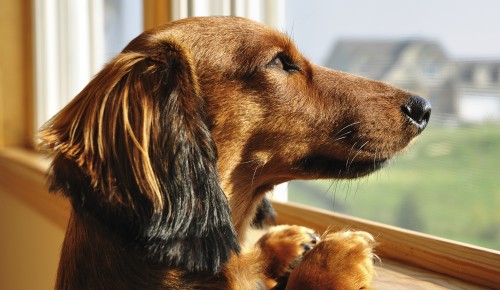
As a veterinary assistant, I see many dogs that struggle with anxiety and owners who are desperately searching for a solution. An anxious pet can put a lot of strain and stress on its family, especially if its anxiety causes it to be destructive. Some dogs express their anxiety by chewing holes in the furniture, others try to break through barriers, and many bark for hours while their families are gone.
All types of dogs can be burdened by anxiety. Very often, they are rescue dogs, and can you blame them? Who knows what tragedies they have faced, and even once they are rescued, waiting for a forever home can be difficult. But even dogs that have always had a loving home can develop anxiety. A medical issue can cause anxiety, which needs to be diagnosed and treated by a trained professional, but sometimes simple things like a scary experience while you were gone (garbage trucks make a lot of terrifying noises!) or not enough exercise or attention can be the culprits. There are a number of reasons why a dog may develop anxiety and as in humans, the problem can continue to escalate if not addressed.
There are many different ways to treat anxiety, and you should always follow your veterinarian's recommendations, but below are some simple steps you can take to help minimize one of its most common forms, separation anxiety:
Change their reaction to you leaving
-
- Teach your dog that when you leave it's not forever by going outside a few times a day for a couples seconds, coming back in, and then repeating the process. Each time, gradually stay outside longer. It may take awhile, but continue this practice every day until your pet no longer seems to mind your absence.
- Reduce anxiety when you are getting ready to leave by shaking up your routine. Going through the same motions every time you head out can cause your dog to negatively respond to certain actions, so try mixing things up. For instance, when you are not about to leave, put on your coat and sit on the couch for a while. Eventually, your dog will stop associating these actions with you leaving, and they will no longer serve as triggers. Also, try picking up your keys and placing them in random places. Picking up car keys is a common trigger because it often indicates one of two things to your dog: either they are going with you or you are about to leave them behind.
- Keep your dogs relaxed while you're gone by not making a big deal out of your departure or your arrival. Calm goodbyes are extremely helpful in minimizing separation anxiety, but so are calm hellos. When you come home, wait until your pet settles down before acknowledging them. While an overjoyed welcome may make you feel good, it indicates how anxiously they were awaiting your return. If it is a party every single time you get home, waiting for you to open that door must be almost impossible to endure.
Wear them out before heading out
-
- The saying that a tired dog is a good dog is very true! While it's never beneficial to leave a dog that is ready to go play, add anxiety to that and you have a recipe for disaster. Walk, hike, run, play, do whatever you can to make sure your dog is worn out before you leave. As an added bonus, actively engaging your pet before heading out gives them more of that one-on-one quality time they can't get when are gone.
Put on some Beethoven
-
- Research suggests that pets prefer classical music because of its relaxing effects, and there are albums created solely to help calm your pets while you're away. Music can also help reduce the stress that outside noises can create. Leaving the radio on, or having a white noise machine in one area of the house along with some low, relaxing music are easy ways to help your pet drown out the outside world and be less nervous.
Treat them to a going-away present
-
- Find that one special thing that your dog absolutely loves, and make sure to give it to them right before you leave. Then, the moment you come home, pick it back up. By giving them something really fun to play with every time you leave and then taking it away when you return, your pet not only learns that it's not all bad when you're gone, but also that they should enjoy that alone time with their favorite toy while they can. The KONG Classic or KONG Genius are very effective at being this 'special thing' because they keep both your pet's body and mind busy as they try to get the treat inside. Those toys are also great because they allow you to adjust the difficultly and challenge of play time while you're gone. Start with something easy so your pet doesn't get discouraged, and once they have the hang of it, gradually increase how hard they have to work to get to the treat inside. For instance, begin with a frozen treat of peanut butter or canned food in a KONG Classic and then eventually move on to some of the KONG puzzle toys.
To any of you who have dealt with an anxious pet, you know that it can be a challenging road and that it takes a long time to reach a healthy place. To those who are just beginning the path to recovery, don't be discouraged. With love, hard work, and plenty of patience, it will get better.





